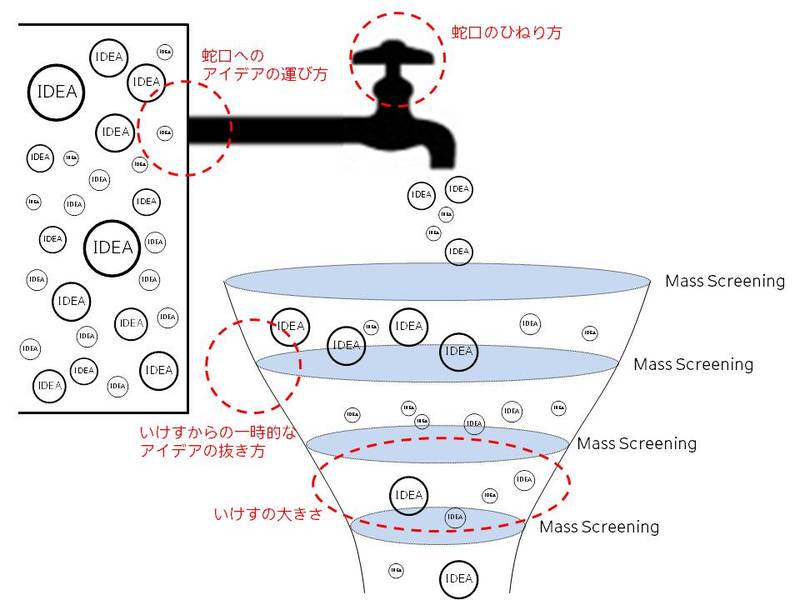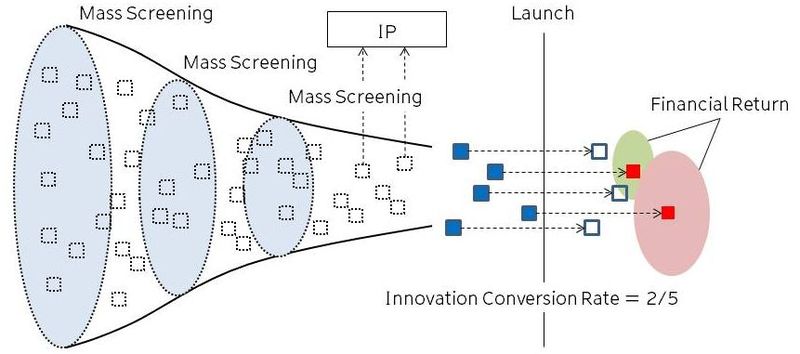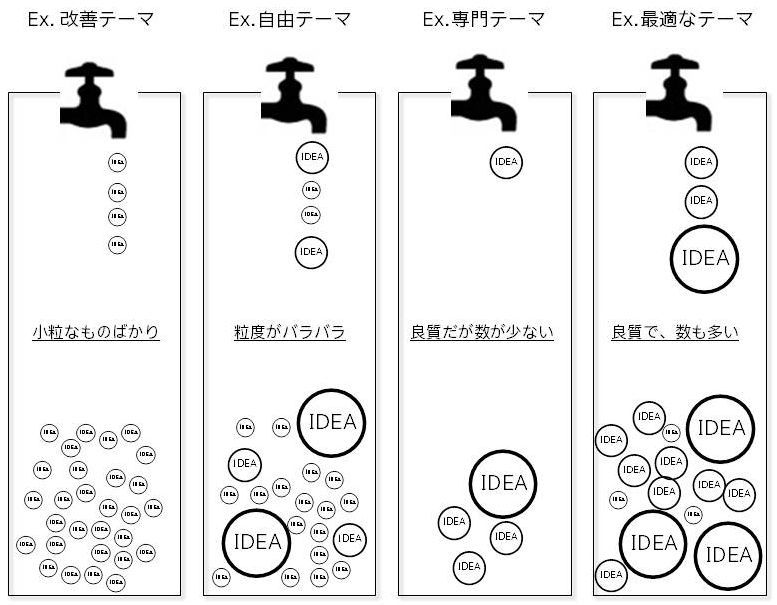Note: This website was automatically translated, so some terms or nuances may not be completely accurate.
Innovation Management Explained: Part 2 The Innovation Management Office as a Transformation Engine
Hello. I'm Akihiro Shimura from the Marketing Innovation Department, Business Development Center, Dentsu Inc. Kansai Branch. Following the first installment, I'll discuss the Innovation Management Office (IMO) – the organization that manages and governs innovation – and related topics as fundamental principles for innovation management leveraging networks.

IMO: The Engine of Corporate Transformation
In overseas companies pursuing advanced innovation, the IMO has become a standard department. In a word, the IMO is the "transformation engine" of a company.
The IMO also focuses on combining past assets (existing technologies, intellectual property: IP) with newly created future assets to generate new value. The methods of combination, the targets for combination, and the distribution channels vary. There is also the perspective of handling idea markets, such as Idea Exchange or Idea Buy, truly performing internal and external Connect & Develop.
It is not like an advisory committee gathering experts from specific businesses or domains. Nor is it a direct intellectual property management or business investment unit, like an incubation department. In other words, it is not the direct driver stretching the business or ideas themselves; it is closer to designing the corporate culture and environment (though it is not about creating taglines or USPs).
Regarding IMO composition, it is often placed under direct organizational control where a broad overview is possible. However, it does not necessarily need to be permanent; sometimes it is established only during the ideation period. The reasons for this are twofold: selecting the personnel to form the IMO can be extremely difficult, making permanent placement impractical in some cases. Additionally, having a defined timeframe can be beneficial, allowing for a dedicated period to review ideas, rather than having the door to ideation open indefinitely. Essentially, the optimal composition method should be determined by focusing on the source—the ideas—and the people to whom they belong.
What exactly does the IMO do? Broadly speaking, it "enables more precise control over 'networked innovation' by holistically managing the entire process depicted in the first Innovation Pipeline diagram: how ideas are transported to the faucet, how the faucet is turned, how ideas are temporarily drawn from the reservoir, and the size of the reservoir itself."
First, regarding "how ideas are transported to the faucet," this encompasses a wide range of activities. Specifically, it includes determining where to connect the pipes leading to the faucet (establishing the population), formulating idea handling policies, risk management through process transparency, managing intrinsic motivation, reward management, and so on. While it also includes analog improvements like office layout changes affecting people in the same space and their associated ideas/knowledge, assume the primary focus is managing a population spread across extensive temporal and spatial areas.
Next is the "how to turn the faucet," which is essentially communication design: determining when, to whom, through what touchpoints, and how to disseminate information. This involves designing promotions and scheduling for idea generation activities. Concretely, it's easiest to think of this as "designing contact points—places and touchpoints where ideas are conceived." The key is implementing gamified information design at each contact point—such as training sessions, meeting rooms with whiteboards, restrooms, baths, homes, bars, or any location where individuals or groups brainstorm—to heighten users' "engagement level." For instance, to ensure ideas are captured without leakage the moment they emerge, if the policy includes submitting ideas via mobile innovation management tools and allowing home access, adjustments to corporate information guidelines will be necessary in coordination with the IT department. Depending on the design, coordination across multiple departments may also be required. Furthermore, since participants may change and external evaluators might join, all activities must be recursive.
Next, "extracting ideas temporarily from the tank" is precisely a transformative action. After thoroughly explaining the initiative, promising ideas requiring early attention (speed-focused ideas to implement now) can be fed directly into existing business domains or enter business feasibility studies without screening. This approach is precisely the bypass innovation<※2> made possible by making the process transparent and disclosing all objectives upfront. An approach like a suggestion box, using black-box screening to "wait and select," lacks the flexibility to respond effectively.
Next, regarding the "size of the fishpond," this aspect also ties into gamification elements for driving motivation. Ideas can be refined, and during this refinement process, a desire for recognition among users emerges, which can serve as a motivating force. For example, if few ideas move from the initial tank to the next, opportunities to satisfy this desire diminish, potentially stifling overall engagement. This depends not only on tank size but also on participant numbers and idea volume. Since these settings are irreversible, data-driven decision-making—including statistical analysis—is essential. This multifaceted topic will be covered in Session 3 and beyond.
Furthermore, we establish performance metrics for the transformation engine encompassing this entire overview diagram—specifically, various innovation-related KPIs/KGIs. Concretely, we set direct and indirect metrics such as the following (commonly referred to as Return On Innovation Investment <ROII>):
1. Innovation Conversion Rate (Successful Ideas ÷ Total Ideas Attempted)
2. Innovation Magnitude (Financial Return ÷ Successful Ideas)
3. Investment Efficiency (Total Ideas Attempted ÷ Capital/Business Investment)
4. Intellectual Asset Conversion Rate (Ideas newly converted to intellectual assets ÷ Total ideas)
etc.
However, defining and judging each of these can be difficult, and there is absolutely no need to use strictly generalized metrics (some are even ones I made up myself). You should instead set your own KPIs/KGIs that truly fit your specific environment and culture, and build your own unique framework. Additionally, we continuously monitor the qualitative and quantitative conditions of ideas themselves, as well as the qualitative and quantitative conditions of the idea owners to whom those ideas belong. For example, in the sales section of a manufacturer's North American sales office, we analyze metrics like the number of idea owners holding department head positions and their growth rate compared to the previous week. All of this feeds into the design of a recursive promotion system.
IMO is the very engine of (corporate) transformation. Just as an engine drives things forward—for better or worse—once it's running, a framework must exist that propels decisions forward. In any case, we absolutely do not seek superficial commentary or analysis. Since it is built on an "approach for making decisions," we cannot afford to be in a situation where we're pushing against a door that's already open. In reality, because decisions made here automatically screen ideas, every day is filled with tension as we carefully and meticulously execute each step. In return, if the system runs smoothly, it becomes possible to operate open innovation with a small team, even when hundreds of thousands of people participate in the emergence process.
The key lies in holistic asset management encompassing not just the future, but the past as well
While innovation often carries a strong future-oriented image of creating new things, a perspective on past assets is frequently overlooked in open innovation and other innovation initiatives.
In today's service design and business design, it's difficult for a single company or stakeholder to establish a robust business alone. Therefore, IMO requires the skill and function (which I call " Intellectual Property Design ") to view ideas and intellectual assets as jigsaw puzzle pieces and combine them, as shown in the diagram below.
Additionally, at a higher operational layer, initiatives themselves must be viewed objectively and managed from CSR and top-level communication perspectives. Depending on how information is processed, this can serve as an excellent opportunity to convey an open corporate culture or highlight the very attitude towards manufacturing and service design (details will be covered in Part 3 and beyond).
In other words, it is crucial to design the implementation of a single ideation activity to generate several times the value by leveraging past assets, external assets, and the objective perspective of the initiative. The more connections are made, the more it ultimately feeds back into the motivation of employees and consumers, who are the source of ideas.
Theme Setting That Determines the Idea Stream
In network-based ideation, the most significant factor influencing idea granularity is the initiative's goal (theme setting) and how that goal is broken down and communicated to participants. As you might imagine from everyday experience, the quality and quantity of ideas generated vary greatly depending on the message directly conveyed to participants.
For instance, simply asking about the company's vision for 100 years versus 10 years ahead changes the granularity of ideas. Filtering words like B2C, B2B, or target categories also significantly alter outcomes. Furthermore, phrases and approaches used to supplement idea generation during offline sessions—such as asking participants to describe in 2-3 lines an area completely unrelated to their job, their least favorite area, or an area where they are absolutely unbeatable by competitors—also greatly influence the results. That said, simply saying "Please freely generate ideas" leads to an unfocused start and is inefficient (though it can be effective as a rapport-building period <※3> to get accustomed to the system). Naturally, it also changes depending on who poses the question (e.g., the CEO or a field manager).
Furthermore, the composition of the idea-generating group significantly impacts the nature of the ideas produced. Innovation often arises when concepts with distant conceptual distances are connected (bypasses). Whether the group is internal only or includes external members, whether it consists of sales or office staff, etc., the quality of ideas changes dramatically with shifts in expertise and mindset.
However, fundamentally, the more participants, the better. Therefore, using the innovation management tools explained in the first session, we meticulously set who receives each piece of information disclosure and when, within the screen components of the online ideation environment. This involves repeatedly tuning the "population × information disclosure" parameters.
After thoroughly discussing and gaining consensus among stakeholders on these settings, we proceed to the step of screening ideas using the "consensus informed by diversity" mentioned in the first session.
In future sessions, we will also cover the challenges leading up to implementation and the rewards of overcoming them, various methods necessary to drive actual online emergence, and multi-tiered reward structures such as monetary rewards, inner rewards, and social rewards. Stay tuned.
(Continued in Part 3 and beyond)
※1 USP: Abbreviation for Unique Selling Proposition. Refers to slogans, messages, or other value propositions that express distinctive benefits driving consumer purchase decisions.
※2 Bypass Innovation: Creating prototypes or commercializing ideas without going through the usual deliberation and approval steps. It can also refer to obtaining information not available through the typical information flow within an organization by hearing ideas or knowledge directly from the idea owner.
※3 Rapport Period: A preparatory phase to establish mutual trust among participants, enabling them to exchange emotions and ideas comfortably. In innovation management, it also implies a period for participants to become familiar with the use of innovation management tools.
Was this article helpful?
Newsletter registration is here
We select and publish important news every day
For inquiries about this article
Back Numbers
Author

Akihiro Shimura
Dentsu Inc.
Marketing Creative Center
Since joining Dentsu Inc. in 2006, he has been engaged in producing national policy projects and smart cities, as well as consulting on advanced technology and system development. Specializing in intellectual property design, he also promotes new business development and international standardization activities. Additionally, he has extensive experience in international conferences, lectures, judging panels, and paper publications related to computer science and mathematical modeling. He holds numerous awards, including IEC International Standardization Expert and the IWRIS Best Paper Award.





